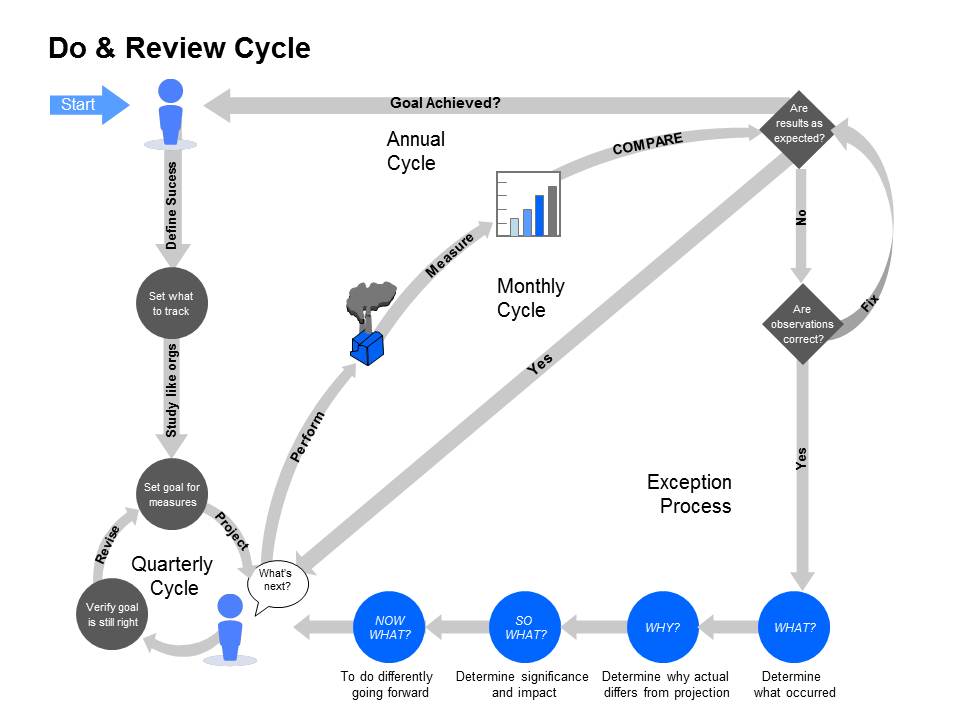It is impossible to control what you cannot, and what you do not, measure. For every important thing that the organization does, decide what is most important to monitor and then watch carefully to know how things are going.
If what to monitor is not known then:
- Watch everything and whittle away what turns out to not be useful and keep watching what turns out to be useful.
- Study similar organizations to learn what they track.
- Look up industry analysts and market researchers to find out what they watch.
Set targets for chosen metrics based on what similar, ideally the best, organizations do. For example, if sales and marketing expenses combined total 15% of revenue for the best organizations that do something similar then use that as a benchmark (i.e., a point of comparison). Note that it is OK to have a different target as long as there is sensible justification.
Prior to any given period of performance, predict how what is about to happen will show up in the targeted measures. Then perform and monitor what happens. Compare measured actual results with what was predicted. The shorthand for this is: Predict-Act-Measure.
Study what happened to determine why what actually happened varied from predicted results. Learn from the experience and then decide what to do differently going forward as a result. The short hand for this process is: What-Why-So What- Now What?
The process chart below diagrams the sequences starting in the upper-left with defining overall success and moving down to the lower-left to determine what to watch based on what others who do something similar watch. Next, in the lower-left, make a projection about what will happen upon performance. Then perform, measure, and compare actual results to projection as suggested along the diagonal to the upper-right. If actual results are in-line with projection then all is well and the cycle is repeated.
 When actual results differ from what was projected, analyze what has happened after making sure measurements are correct, to move from the upper-right to the lower-right.
When actual results differ from what was projected, analyze what has happened after making sure measurements are correct, to move from the upper-right to the lower-right.
Moving from the lower-right along the bottom back to the lower-left are the four all-important questions:
- What happened?
- Why is what happened different than what was projected to happen?
- What is learned from this? and
- What will be done differently going forward as a result of what has been learned?
Appropriate changes are implemented and the entire process is then repeated over and over until desired results are achieved and the ultimate long-term goal is reached.
Summary
Every important thing an organization does should be subject to a continuous and rigorous Do & Review cycle. Doing so is essential for the organization to learn, to grow, and to perform up to its potential.
The Do & Review cycle is a planning and control learning model that works with everything any one or any organization wants to do in a predictable and improving way. As such it is ideally applied to the three core systems of any organization; i.e., the systems we referred to earlier as:
- Do,
- Sell, and
- Grow.
Ensure compare and explain projected and actual results to:
- What others (especially the best) do to look for and demonstrate favorable comparison to others in an industry.
- What the organization has done previously to look for and demonstrate continuous growth and improvement.
- What was supposed to happen according to plan and projection to demonstrate consistent accountability to a plan.
Note that the virtues of Do & Review apply to every level of system (person, team, unit, organization, etc.) and in all time-spans (i.e., monthly, quarterly, annually, etc.).

One thought on “Four questions an organization needs to ask every performance period in order to perform, learn, and grow to its full potential.”